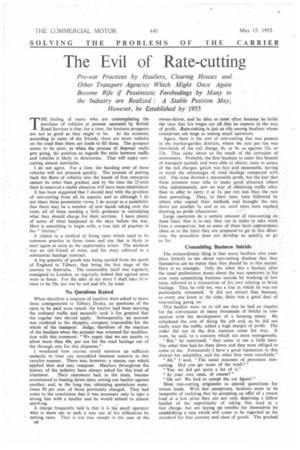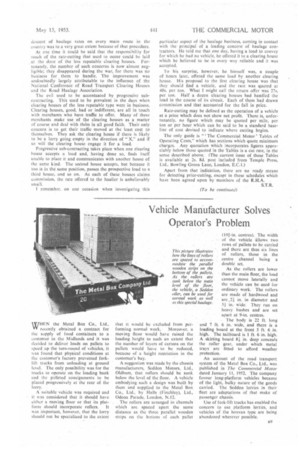The Evil of Rate-cutting
Page 42

Page 43

If you've noticed an error in this article please click here to report it so we can fix it.
Pre-war Practices by Hauliers, Clearing Houses and Other Transport Agencies Which Might Once Again Become Rife if Pessimistic Forebodings by Many in the Industry are Realized : A Stable Position May,
However, be Established by 1955 THE feeling of many who are contemplating the purchase of vehicles at present operated by British Road Services is that, for a time, the business prospects are not as good as they ought to be. At the moment, according to some of my friends, there are more vehicles on the road than there are loads to fill them. The prospect seems to be poor, as when the process of disposal really gets going, the position as regards the ratio between traffic and vehicles is likely to deteriorate. That will make ratecutting almost inevitable.
I do not agree. For a time, the handing over of these vehicles will not proceed quickly. The process of putting back the fleets of vehicles into the hands of free enterprise cannot be other than gradual, and by the time the 25-mile limit is removed a stable situation will have been established.
It has been suggested that I should deal with the problem of rate-cutting from all its aspects, and so although I do not share these pessimistic views. J do accept as a possibility that there may be a number of new hands taking over the reins, all of them needing a little guidance in calculating what they should charge for their services. I have plenty of notes of what happened in the days before the war. Here is something to begin with; a true tale of practice in the " 'thirties."
It relates to a method of fixing rates which used to be common practice in those times and one that is likely to start again as soon as the opportunity arises. The narrator 4 was an old 'friend of mine, and his story referred to a substantial haulage contract.
A big quantity of goods was being carried from the north of England to Tilbury, that being the first stage of the journey to Australia. The commodity itself was regularly consigned to London, so regularly indeed that agreed rates were in force. For the sake of my story I shall take thcso rates to be 50s. per ton by rail and 45s. by road.
No Questions Raised
When therefore a concern of hauliers were asked to move these consignments to Tilbury Docks, no questions of the rates to be paid were raised: the haulier had been carrying the ordinary traffic and naturally took it for granted that the regular rate shculd apply. Subsequently, an account was rendered to the shippin3 company responsible for the whole of the transport. Judge, therefore of the reaction of the hauliers when the account was returned for modification with this comment: "We regret that we are unable to allow more than 40s. per ton for the road haulage out of the through rate for this shipment."
I wondered how anyone could summon up sufficient audacity to treat :lily accredited business concern in this cavalier manner. There was, however, a reason, one which applied then and may reappear. Hauliers throughout the history of the industry have always asked for this kind of treatment. Their customers had, in the main, become accustomed to beating down rates, setting one haulier against another, and, in the long run, obtaining quotations sometimes 50 per cent, of those previously charged. They had come to the conclusion that it was necessary only to take a strong line with a haulier and he would submit to almost anything. .
A charge frequently laid is that it is the small operator who is more apt to seek a way out of his difficulties by " cutting rates. That is not true except in the case of the, a8 owner-driver, and he does so most often because he holds the view that his wages are all that he expects in the way of profit. ,Rate-cutting is just as rife among hauliers whose enterprises are large as among small operators.
Again, there is the sort of rate-cutting that was present in the market-garden districts, where the rate per ton was two-thirds of the rail charge, 8s. or 98. as against 12s. or 13s. That came about as the result of the intrusion of newcomers. Probably the first hauliers to enter this branch of transport quoted, and were able to obtain, rates in excess of the rail charges, which was fair and reasonable, having in mind the advantages of road haulage compared with , rail. The rates showed a reasonable profit, but the fact that these pioneers were able to make good attracted others. who, unfortunately, saw no way of obtaining traffic other than to offer to carry it at Is. per ton less than the rate then prevailing. They, in their turn, were followed by others who copied their methods and brought the rate down yet another Is. and so on, until rates were reached, showing no profit whatsoever. Large operators do a certain amount of rate-cutting on these lines; that is to say, they cut in order to take work . from a competitor, but as some of them have approximate ideas as to the limit they are prepared to go in this direction, the procedure does not develop as quickly, or go as far.
Committing Business Suicide
The extraordinary thing is that many hauliers who complain bitterly to me about rate-cutting disclose that they themselves are no better than they should be in this matter. Here is an example. Only the other day a haulier, after the usual preliminary moan about the way operators in his area were committing business suicide by working at low rates, referred to a transaction of his own relating to brick haulage. This, he told me, was a line in which he was not particularly interested. It did not attract him because, as every one knew at the tittle, there was a good deal of rate-cutting going on. This haulier went on to tell me that he had an inquiry for the conveyance of many thousands of bricks in connection with the development of a housing estate. He calculated the cost of doing the job and, as he did not really want the traffic, added a high margin of profit. The order did not in the first instance come his way. It went, he said, to a concern which cut. rates outrageously. "But," he continued, "they came to me a little later. The other firm had let them down and they were obliged to come to me. Fortunately I have a good reputation in this district for reliability, and the other firm were unreliable." "Ah," I said, "The usual outcome of persistent ratecutting. Did you get more of the work?" "Yes; we did get quite a lot of it." "At your own rates, of course?" "Oh no! We had to accept the cut figure!"
Most rate-cutting originates in special quotations for return loads. With few exceptions, hauliers seem to be incapable of realizing that by accepting an offer of a return load at a low price they are not only depriving a fellow haulier of the opportunity of taking that load at a fair charge, but are laying up trouble for themselves by establishing a rate which will come to be regarded as the standard for that journey and class of goods. The gradual descent of haulage rates on every main route in the country was to a very great extent because of that procedure.
At one time it could be said that the responsibility for much of the rate-cutting that used to occur could be laid at the door of the less reputable clearing houses. Fortunately, the number of such concerns is now almost negligible; they disappeared during the war, for there was no business for them to handle. The improvement was undoubtedly largely attributable to the influence of the National. Conference of Road Transport Clearing Houses and the Road Haulage Association.
The evil used to be accentuated by progressive subcontracting. This used to be prevalent in the days when clearing houses of the less reputable type were in business. Clearing houses, good, bad or indifferent, are all in touch with merchants who have traffic to offer. Many of these merchants make use of the clearing houses as a matter of course and deal with them in all good faith. Their only concern is to get their traffic moved at the least cost to themselves. They ask the clearing house if there is likely to he a lorry going empty in the direction of "X," and if so will the clearing house engage it for a load.
Progressive sub-contracting takes place when one clearing house accepts a load and, having done so, finds itself unable to place it and communicates with another house of the same kind. The second house accepts, but because it too is in the same position, passes the prospective load to a third house, and so on. As each of these houses claims commission, the rate offered to the haulier is unbelievably I remember, on one occasion when investigating this particular aspect of the haulage business, coming in contact with the principal of a leading concern of haulage contractors. He told me that one day, having a load to convey for which he had no vehicle, he offered it to a clearing house which he believed to be in every way reliable and it was accepted.
To his surprise, however, he himself was, a couple of hours later, offered the same load by another clearing house. His proposal to the first clearing house was that they should find a vehicle, and the rate was quoted at 48s. per ton. What I might call the return offer was 27s. per ton. Half a dozen clearing houses had handled the load in the course of its circuit. Each of them had drawn commission and that accounted for the fall in price.
Rate-cutting may be defined as the operation of a vehicle at a price which does not show net profit. There is, unfortunately, no figure which may be quoted per mile, per ton or per hour which can be said to be a standard baseline of cost devised to indicate where cutting begins.
The only guide is "' The Commercial Motor' Tables of Operating Costs,which has sections which quote minimum charges. Any quotation which incorporates figures appreciably below those quoted in the Tables is a cut rate, in the sense described above. (The current issue of these Tables is available at 2s. 8d. post included from Temple Press, Ltd., Bowling Green Lane, London, E.C.1.)
Apart from that indication, there are no ready means for detecting price-cutting, except in those schedules which have been agreed upon by members of the R.H.A.
S.T.R.




























































































